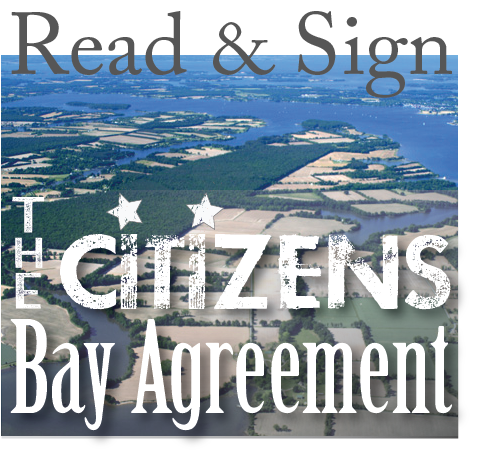Chesapeake Bay Action Plan
After decades of effort, the voluntary, collaborative approach to restoring the health and vitality of the Chesapeake Bay— the largest estuary in the United States—has not worked and, in fact, is failing.
A diverse group of 57 senior scientists and policymakers have joined forces to save the Bay. This is our plan.
Our Natural Heritage Sqaundered
Posted by Gerald Winegrad.
As we celebrate the Christmas season and anticipate the coming New Year with family and friends, my thoughts have turned inward. Now in my mid-60’s, I think deep thoughts of the way things used to be and how radically things have changed. Sadly, as I reflect on the Chesapeake Bay and its mighty rivers and its many streams, I see the results of the slow but ongoing degradation and poisoning of this natural legacy.
United We Stand?
Posted by Fred Tutman.
In our Bay preservation movement there some among us are deeply committed to compatible ideals and to the environment but lack the momentum or body politic to communicate their views clearly or beyond the narrow subset of environmentalism they represent. We are often divided within—as much by interest group as by our vision of what winning actually looks like. Such of our subsets are just not mainstream enough by orientation to communicate comfortably with those outside their own choir, but we include them by reference in order to swell our ranks. Truthfully, these are folks who have a smaller (but important) vision not always shared by all.
Environmental Coalitions That Get Results
As environmentalists who care about our planet and our society we operate in an increasingly slippery environment in terms of gaining traction for our vision for clean water and strong communities. In tough economic times we are often seen not as champions of the public interest, but as adversaries of the economic system. I think we need a makeover of our tactics if we hope to make a real difference.
Why We Lose (Part IV)
(Posted by Howard Ernst.)
The Chesapeake Bay Commission describes itself as a tri-state legislative commission created in 1980 “to advise the members of the General Assemblies of Maryland, Virginia, and Pennsylvania on matters of Bay-wide concern.” Yet the majority of its elected members have poor environmental voting records…
Why is Chesapeake Bay so vulnerable (and productive)?
(Posted by Bill Dennison.) Chesapeake Bay is particularly vulnerable to human impacts and incredibly productive for three basic reasons. 1) The first of these reasons is that Chesapeake Bay is an estuary, a place where fresh and salt water mix. 2) The second of these reasons is due to the geographic setting; geomorphology and hydrography…
Population + Paving = Pollution, Part Two
This part of the story (see part one) starts with work done by Dr. Grace Brush, a long-term faculty member at Johns Hopkins University. Grace and her students use a variety of techniques to “look back in time” to reconstruct what the Chesapeake Bay and watershed looked like in the past, even as far back as 14,000 years ago.
What they found was interesting and useful for all people living in this basin. For example, Grace found when John Smith starting exploring the Chesapeake the basin was “almost entirely covered with a diversity of forests on a wide variety of soils, drained by an intricate and dense system of over 100,000 streams and 150 major rivers surrounded by large marshes.” In addition, “beavers were abundant…building local dams and impoundments on ..virtually all… streams…the environment was wet and marshy throughout.”
J. Chuck Fox–Thank You
On December 3, 2008 an unprecedented event took place in Annapolis, Maryland. A group of twenty distinguished Chesapeake Bay scientists and policy experts crowded into a small room at the Maryland Inn to discuss the fate of the Bay restoration effort. The meeting itself was not particularly significant, most of the people in the room knew each other and all the attendees had participated in similar discussions in the past, but what the participants had to say was groundbreaking. Within a short period of time, the diverse group of environmental experts agreed to a unanimous statement regarding the Bay restoration effort. Their statement declared that the voluntary/collaborative structures under the formal Bay Program had not succeeding and, as a consequence, the Bay’s health was declining, not improving:
Population + Paving = Pollution
The population of Calvert County in 1969 was about 17,000 people, there were two stoplights in the entire county and the nearest movie theater was in Annapolis. No one bothered with the stop signs because it was obvious no one was coming! Calvert now sports a population of almost 90,000 people and has stoplights galore. Houses have popped up all over the place as have businesses, schools and restaurants. Not as rural as it used to be and a lot more paved.
We are senior Chesapeake Bay scientists and policymakers from Maryland, Virginia and Pennsylvania who have concluded that after decades of effort, the voluntary, collaborative approach to restoring the health and vitality of the largest estuary in the United States has not worked and, in fact, is failing. Our group unanimously recommends that all states draining into the Chesapeake Bay adopt our 25 action items in their Watershed Implementation Plans (WIP) and implement them to improve the Bay’s water quality and to meet the requirements of the Clean Water Act.
Sign up for news & updates from Patuxent Riverkeeper
